Yuqi Wu
SafeWork-R1: Coevolving Safety and Intelligence under the AI-45$^{\circ}$ Law
Jul 24, 2025Abstract:We introduce SafeWork-R1, a cutting-edge multimodal reasoning model that demonstrates the coevolution of capabilities and safety. It is developed by our proposed SafeLadder framework, which incorporates large-scale, progressive, safety-oriented reinforcement learning post-training, supported by a suite of multi-principled verifiers. Unlike previous alignment methods such as RLHF that simply learn human preferences, SafeLadder enables SafeWork-R1 to develop intrinsic safety reasoning and self-reflection abilities, giving rise to safety `aha' moments. Notably, SafeWork-R1 achieves an average improvement of $46.54\%$ over its base model Qwen2.5-VL-72B on safety-related benchmarks without compromising general capabilities, and delivers state-of-the-art safety performance compared to leading proprietary models such as GPT-4.1 and Claude Opus 4. To further bolster its reliability, we implement two distinct inference-time intervention methods and a deliberative search mechanism, enforcing step-level verification. Finally, we further develop SafeWork-R1-InternVL3-78B, SafeWork-R1-DeepSeek-70B, and SafeWork-R1-Qwen2.5VL-7B. All resulting models demonstrate that safety and capability can co-evolve synergistically, highlighting the generalizability of our framework in building robust, reliable, and trustworthy general-purpose AI.
Streaming 4D Visual Geometry Transformer
Jul 15, 2025Abstract:Perceiving and reconstructing 4D spatial-temporal geometry from videos is a fundamental yet challenging computer vision task. To facilitate interactive and real-time applications, we propose a streaming 4D visual geometry transformer that shares a similar philosophy with autoregressive large language models. We explore a simple and efficient design and employ a causal transformer architecture to process the input sequence in an online manner. We use temporal causal attention and cache the historical keys and values as implicit memory to enable efficient streaming long-term 4D reconstruction. This design can handle real-time 4D reconstruction by incrementally integrating historical information while maintaining high-quality spatial consistency. For efficient training, we propose to distill knowledge from the dense bidirectional visual geometry grounded transformer (VGGT) to our causal model. For inference, our model supports the migration of optimized efficient attention operator (e.g., FlashAttention) from the field of large language models. Extensive experiments on various 4D geometry perception benchmarks demonstrate that our model increases the inference speed in online scenarios while maintaining competitive performance, paving the way for scalable and interactive 4D vision systems. Code is available at: https://github.com/wzzheng/StreamVGGT.
Point3R: Streaming 3D Reconstruction with Explicit Spatial Pointer Memory
Jul 03, 2025Abstract:Dense 3D scene reconstruction from an ordered sequence or unordered image collections is a critical step when bringing research in computer vision into practical scenarios. Following the paradigm introduced by DUSt3R, which unifies an image pair densely into a shared coordinate system, subsequent methods maintain an implicit memory to achieve dense 3D reconstruction from more images. However, such implicit memory is limited in capacity and may suffer from information loss of earlier frames. We propose Point3R, an online framework targeting dense streaming 3D reconstruction. To be specific, we maintain an explicit spatial pointer memory directly associated with the 3D structure of the current scene. Each pointer in this memory is assigned a specific 3D position and aggregates scene information nearby in the global coordinate system into a changing spatial feature. Information extracted from the latest frame interacts explicitly with this pointer memory, enabling dense integration of the current observation into the global coordinate system. We design a 3D hierarchical position embedding to promote this interaction and design a simple yet effective fusion mechanism to ensure that our pointer memory is uniform and efficient. Our method achieves competitive or state-of-the-art performance on various tasks with low training costs. Code is available at: https://github.com/YkiWu/Point3R.
Estimating Quality in Therapeutic Conversations: A Multi-Dimensional Natural Language Processing Framework
May 09, 2025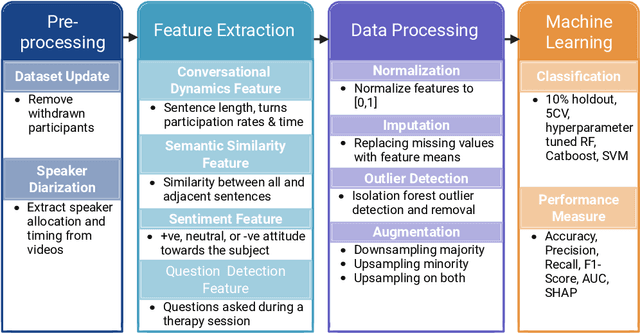
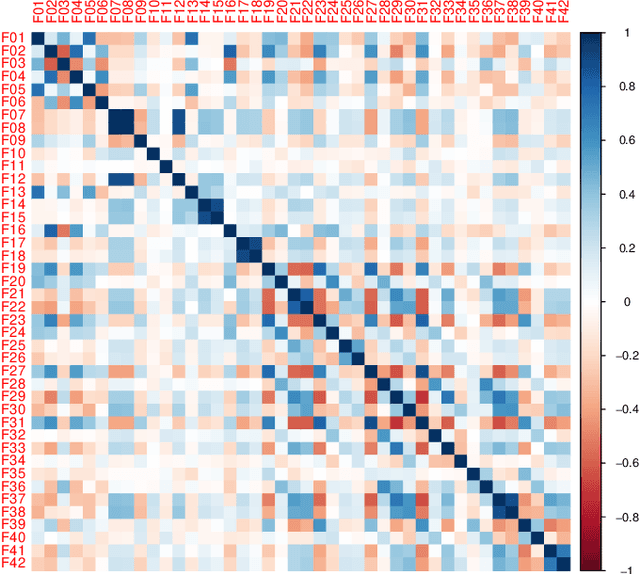
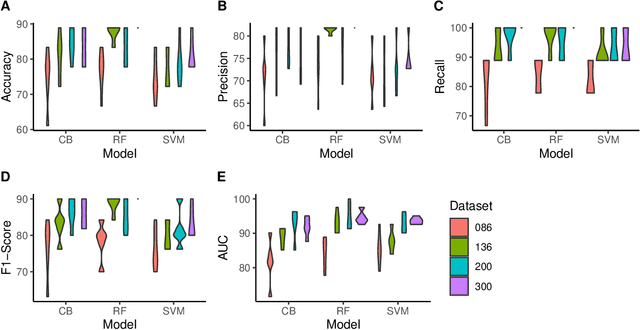
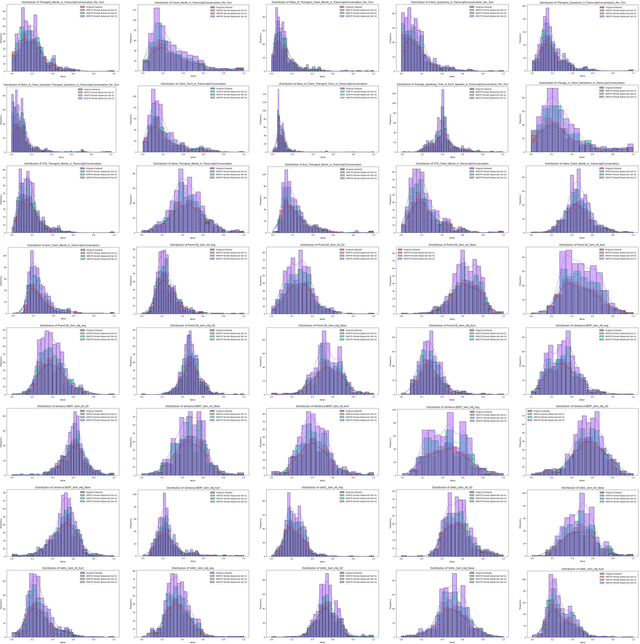
Abstract:Engagement between client and therapist is a critical determinant of therapeutic success. We propose a multi-dimensional natural language processing (NLP) framework that objectively classifies engagement quality in counseling sessions based on textual transcripts. Using 253 motivational interviewing transcripts (150 high-quality, 103 low-quality), we extracted 42 features across four domains: conversational dynamics, semantic similarity as topic alignment, sentiment classification, and question detection. Classifiers, including Random Forest (RF), Cat-Boost, and Support Vector Machines (SVM), were hyperparameter tuned and trained using a stratified 5-fold cross-validation and evaluated on a holdout test set. On balanced (non-augmented) data, RF achieved the highest classification accuracy (76.7%), and SVM achieved the highest AUC (85.4%). After SMOTE-Tomek augmentation, performance improved significantly: RF achieved up to 88.9% accuracy, 90.0% F1-score, and 94.6% AUC, while SVM reached 81.1% accuracy, 83.1% F1-score, and 93.6% AUC. The augmented data results reflect the potential of the framework in future larger-scale applications. Feature contribution revealed conversational dynamics and semantic similarity between clients and therapists were among the top contributors, led by words uttered by the client (mean and standard deviation). The framework was robust across the original and augmented datasets and demonstrated consistent improvements in F1 scores and recall. While currently text-based, the framework supports future multimodal extensions (e.g., vocal tone, facial affect) for more holistic assessments. This work introduces a scalable, data-driven method for evaluating engagement quality of the therapy session, offering clinicians real-time feedback to enhance the quality of both virtual and in-person therapeutic interactions.
Understanding LLM Scientific Reasoning through Promptings and Model's Explanation on the Answers
May 02, 2025Abstract:Large language models (LLMs) have demonstrated remarkable capabilities in natural language understanding, reasoning, and problem-solving across various domains. However, their ability to perform complex, multi-step reasoning task-essential for applications in science, medicine, and law-remains an area of active investigation. This paper examines the reasoning capabilities of contemporary LLMs, analyzing their strengths, limitations, and potential for improvement. The study uses prompt engineering techniques on the Graduate-Level GoogleProof Q&A (GPQA) dataset to assess the scientific reasoning of GPT-4o. Five popular prompt engineering techniques and two tailored promptings were tested: baseline direct answer (zero-shot), chain-of-thought (CoT), zero-shot CoT, self-ask, self-consistency, decomposition, and multipath promptings. Our findings indicate that while LLMs exhibit emergent reasoning abilities, they often rely on pattern recognition rather than true logical inference, leading to inconsistencies in complex problem-solving. The results indicated that self-consistency outperformed the other prompt engineering technique with an accuracy of 52.99%, followed by direct answer (52.23%). Zero-shot CoT (50%) outperformed multipath (48.44%), decomposition (47.77%), self-ask (46.88%), and CoT (43.75%). Self-consistency performed the second worst in explaining the answers. Simple techniques such as direct answer, CoT, and zero-shot CoT have the best scientific reasoning. We propose a research agenda aimed at bridging these gaps by integrating structured reasoning frameworks, hybrid AI approaches, and human-in-the-loop methodologies. By critically evaluating the reasoning mechanisms of LLMs, this paper contributes to the ongoing discourse on the future of artificial general intelligence and the development of more robust, trustworthy AI systems.
ProAI: Proactive Multi-Agent Conversational AI with Structured Knowledge Base for Psychiatric Diagnosis
Feb 28, 2025Abstract:Most LLM-driven conversational AI systems operate reactively, responding to user prompts without guiding the interaction. Most LLM-driven conversational AI systems operate reactively, responding to user prompts without guiding the interaction. However, many real-world applications-such as psychiatric diagnosis, consulting, and interviews-require AI to take a proactive role, asking the right questions and steering conversations toward specific objectives. Using mental health differential diagnosis as an application context, we introduce ProAI, a goal-oriented, proactive conversational AI framework. ProAI integrates structured knowledge-guided memory, multi-agent proactive reasoning, and a multi-faceted evaluation strategy, enabling LLMs to engage in clinician-style diagnostic reasoning rather than simple response generation. Through simulated patient interactions, user experience assessment, and professional clinical validation, we demonstrate that ProAI achieves up to 83.3% accuracy in mental disorder differential diagnosis while maintaining professional and empathetic interaction standards. These results highlight the potential for more reliable, adaptive, and goal-driven AI diagnostic assistants, advancing LLMs beyond reactive dialogue systems.
EmbodiedOcc: Embodied 3D Occupancy Prediction for Vision-based Online Scene Understanding
Dec 05, 2024Abstract:3D occupancy prediction provides a comprehensive description of the surrounding scenes and has become an essential task for 3D perception. Most existing methods focus on offline perception from one or a few views and cannot be applied to embodied agents which demands to gradually perceive the scene through progressive embodied exploration. In this paper, we formulate an embodied 3D occupancy prediction task to target this practical scenario and propose a Gaussian-based EmbodiedOcc framework to accomplish it. We initialize the global scene with uniform 3D semantic Gaussians and progressively update local regions observed by the embodied agent. For each update, we extract semantic and structural features from the observed image and efficiently incorporate them via deformable cross-attention to refine the regional Gaussians. Finally, we employ Gaussian-to-voxel splatting to obtain the global 3D occupancy from the updated 3D Gaussians. Our EmbodiedOcc assumes an unknown (i.e., uniformly distributed) environment and maintains an explicit global memory of it with 3D Gaussians. It gradually gains knowledge through local refinement of regional Gaussians, which is consistent with how humans understand new scenes through embodied exploration. We reorganize an EmbodiedOcc-ScanNet benchmark based on local annotations to facilitate the evaluation of the embodied 3D occupancy prediction task. Experiments demonstrate that our EmbodiedOcc outperforms existing local prediction methods and accomplishes the embodied occupancy prediction with high accuracy and strong expandability. Our code is available at: https://github.com/YkiWu/EmbodiedOcc.
Dynamic Self-Consistency: Leveraging Reasoning Paths for Efficient LLM Sampling
Aug 30, 2024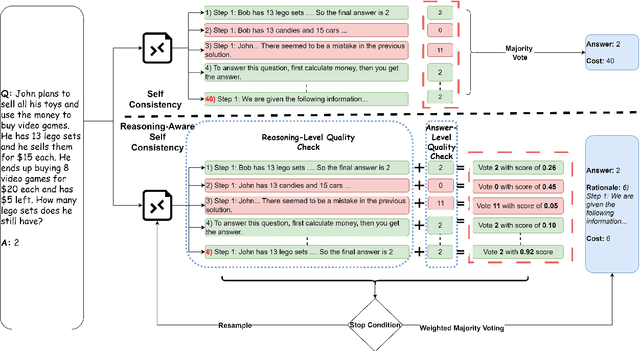
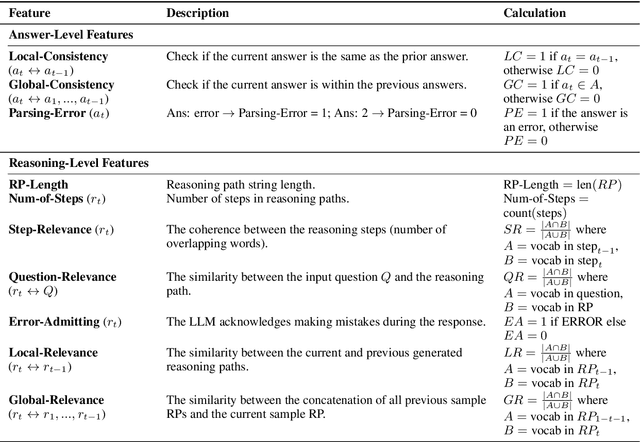
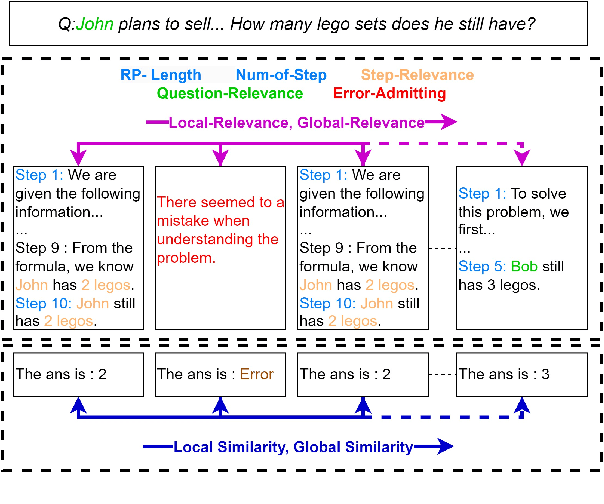
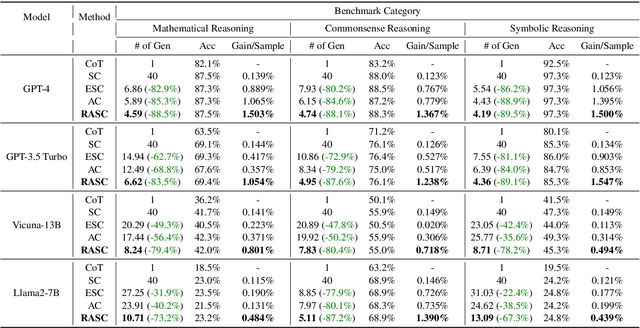
Abstract:Self-Consistency (SC) is a widely used method to mitigate hallucinations in Large Language Models (LLMs) by sampling the LLM multiple times and outputting the most frequent solution. Despite its benefits, SC results in significant computational costs proportional to the number of samples generated. Previous early-stopping approaches, such as Early Stopping Self Consistency and Adaptive Consistency, have aimed to reduce these costs by considering output consistency, but they do not analyze the quality of the reasoning paths (RPs) themselves. To address this issue, we propose Reasoning-Aware Self-Consistency (RASC), an innovative early-stopping framework that dynamically adjusts the number of sample generations by considering both the output answer and the RPs from Chain of Thought (CoT) prompting. RASC assigns confidence scores sequentially to the generated samples, stops when certain criteria are met, and then employs weighted majority voting to optimize sample usage and enhance answer reliability. We comprehensively test RASC with multiple LLMs across varied QA datasets. RASC outperformed existing methods and significantly reduces sample usage by an average of 80% while maintaining or improving accuracy up to 5% compared to the original SC
CoT Rerailer: Enhancing the Reliability of Large Language Models in Complex Reasoning Tasks through Error Detection and Correction
Aug 25, 2024Abstract:Chain-of-Thought (CoT) prompting enhances Large Language Models (LLMs) complex reasoning abilities by generating intermediate steps. However, these steps can introduce hallucinations and accumulate errors. We propose the CoT Rerailer to address these challenges, employing self-consistency and multi-agent debate systems to identify and rectify errors in the reasoning process. The CoT Rerailer first selects the most logically correct Reasoning Path (RP) using consistency checks and critical evaluation by automated agents. It then engages a multi-agent debate system to propose and validate corrections to ensure the generation of an error-free intermediate logical path. The corrected steps are then used to generate a revised reasoning chain to further reduce hallucinations and enhance answer quality. We demonstrate the effectiveness of our approach across diverse question-answering datasets in various knowledge domains. The CoT Rerailer enhances the reliability of LLM-generated reasoning, contributing to more trustworthy AI driven decision-making processes.
Use of natural language processing to extract and classify papillary thyroid cancer features from surgical pathology reports
May 22, 2024



Abstract:Background We aim to use Natural Language Processing (NLP) to automate the extraction and classification of thyroid cancer risk factors from pathology reports. Methods We analyzed 1,410 surgical pathology reports from adult papillary thyroid cancer patients at Mayo Clinic, Rochester, MN, from 2010 to 2019. Structured and non-structured reports were used to create a consensus-based ground truth dictionary and categorized them into modified recurrence risk levels. Non-structured reports were narrative, while structured reports followed standardized formats. We then developed ThyroPath, a rule-based NLP pipeline, to extract and classify thyroid cancer features into risk categories. Training involved 225 reports (150 structured, 75 unstructured), with testing on 170 reports (120 structured, 50 unstructured) for evaluation. The pipeline's performance was assessed using both strict and lenient criteria for accuracy, precision, recall, and F1-score. Results In extraction tasks, ThyroPath achieved overall strict F-1 scores of 93% for structured reports and 90 for unstructured reports, covering 18 thyroid cancer pathology features. In classification tasks, ThyroPath-extracted information demonstrated an overall accuracy of 93% in categorizing reports based on their corresponding guideline-based risk of recurrence: 76.9% for high-risk, 86.8% for intermediate risk, and 100% for both low and very low-risk cases. However, ThyroPath achieved 100% accuracy across all thyroid cancer risk categories with human-extracted pathology information. Conclusions ThyroPath shows promise in automating the extraction and risk recurrence classification of thyroid pathology reports at large scale. It offers a solution to laborious manual reviews and advancing virtual registries. However, it requires further validation before implementation.
 Add to Chrome
Add to Chrome Add to Firefox
Add to Firefox Add to Edge
Add to Edge